7 Awesome Things You Can Make with Wood Pallets
Whether your style is rustic or industrial, left-for-trash pallets can be turned into winning pieces of furniture. Here, bloggers share their best projects that can be done in a weekend—or less.
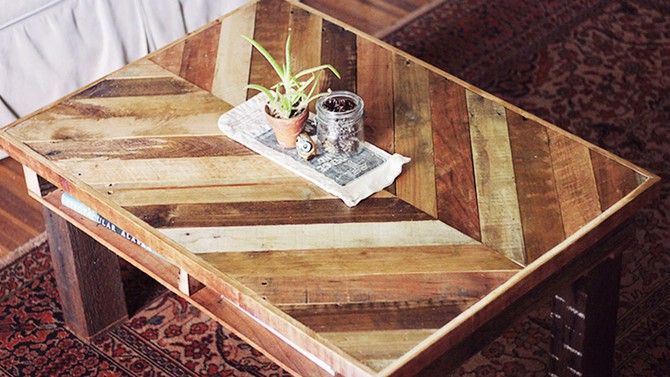
Photo: The Merrythought
A Catalog-Worthy Coffee Table That's Easier to Make Than You'd Think
Project Time: 1 day
Key Step: To create the chevron pattern, take a cut-to-size piece of plywood and draw a line directly down the center. Trim down the width of the pallet boards (we suggest 2-2½-inches wide and cut 45-degree angles at each end. Glue and then nail the boards to the plywood. Parts of the pallets will likely hang over the edge of the plywood and these should be cut off to sit flush with the base.
Don't Forget: Stain all the pieces first before building the coffee table. The contrasting wood effect is a great way to accentuate the chevron pattern and can be done by staining the pallets in a varying number of coats.
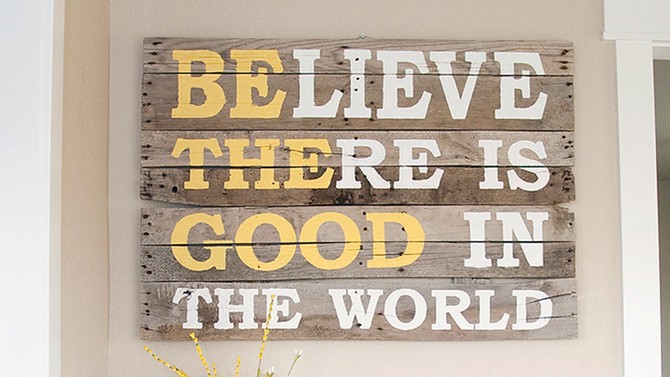
Photo: Marie Chorak, The Blooming Homestead
A Personalized Piece of Art That Requires Little Creativity
Project Time: 4 hours
Key Steps: Cut the wood to your desired size, then paint quote, using latex-based paint. Once the quote's paint is dry (for those with bad penmanship, there are stencils for that), lay out the boards so the text is facing down and nail two vertical boards to the back—making sure each horizontal one is nailed in—which will hold the sign together.
Don't Forget: After you properly dismantle the pallet, remove any nails from the wood before you start painting, especially rusty ones that can potentially cause tetanus.
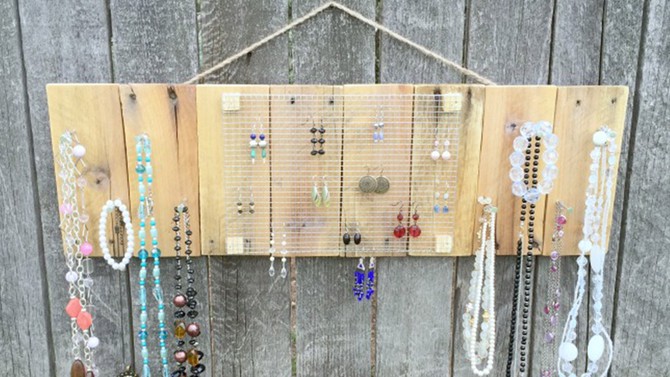
Photo: Mindi Carwin, My Love 2 Create
A Jewelry Holder That Doesn't Hide Your Baubles
Project Time: 3 hours
Key Steps: Glue cut-to-size pallets to the front of a long piece of plywood—making sure no edges of plywood are exposed. All you need to do next is add nails to hang jewelry from and staple a piece of rope to the back so it can hang on a wall. An optional step for those who've dealt with mismatched earrings one too many times: Cut a rectangular piece of hardware cloth and hot glue small square scraps of wood to its corners. Nail these pieces of wood to your desired location on the pallet.
Don't Forget: When choosing which pallets to work with, always look for a "HT" stamp on the wood, which means it has been heat-treated instead of chemically-treated. If you do not see this stamp, you run the risk of exposing yourself to potentially harmful chemicals. Never use boards that smell, look oily, are extra heavy or have too many nails, as they can be harmful—or just too hard to work with—as well.
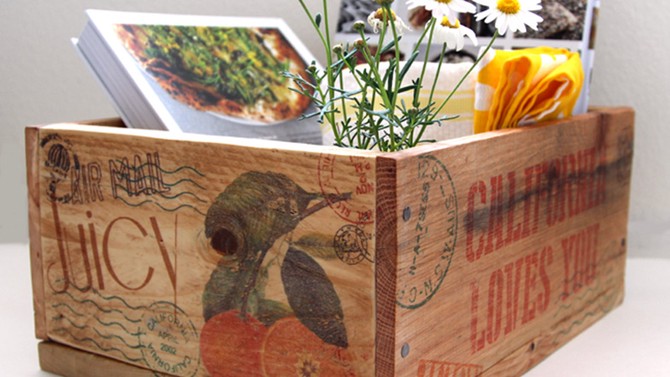
Photo: Ananda, A Piece of Rainbow
A Catchall Storage Container That Beats Plastic Bins
Project Time: 3 hours
Key Steps: As before, cut wood to desired size and pre-drill small holes to prevent cracks in the wood and then nail the crate together. Then print images (you can find a great online selection here) onto a piece of wax paper taped to the top of an 8½-by-11-inch sheet of paper. (Remember to reverse the images on a photo-editing program before you print). To transfer the images onto the wood, wet the surface with a cloth and water and then press down on the wax paper using a soft pad.
Don't Forget: Since wood pallets are often left outdoors or used for shipping (which makes them prone to food contamination and product spillage), you cannot guarantee that they are 100-percent bacteria-free. Before you begin any pallet project, scrub down the wood with soap and water. However, since bacteria can become embedded into the wood, it's best to play it safe and keep them away from anything that could come in contact with your mouth—so don't store fruits or veggies in this.
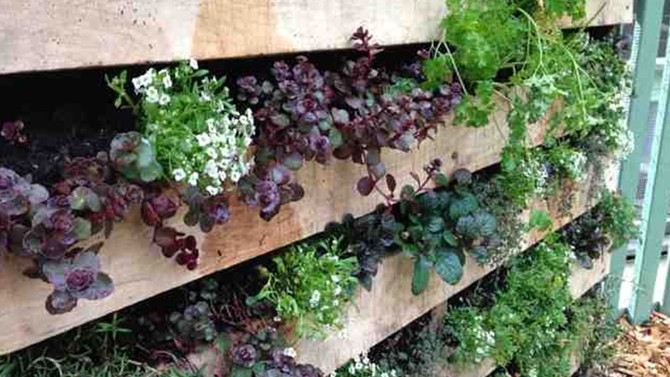
Photo: Alex Tower Ewers, Repurposed Playground
The Garden Even the No-Backyard-Folk Can Create
Project Time: 4 hours
Key Steps: Staple landscaping fabric to the back, bottom and sides of one full pallet, double or triple layer it and then fold the corners in so no soil can spill out. With the pallet laying flat down, pour potting soil in through the boards and add plants from the bottom up, adding more soil as necessary.
Don't Forget: To find a better deal on pricey landscaping fabric, search for rolls on Craigslist or ask for leftover scraps from a local gardening store. Another tip: Leave the pallet lying down for one to two weeks before turning it upright. This gives the plants enough time to take root.
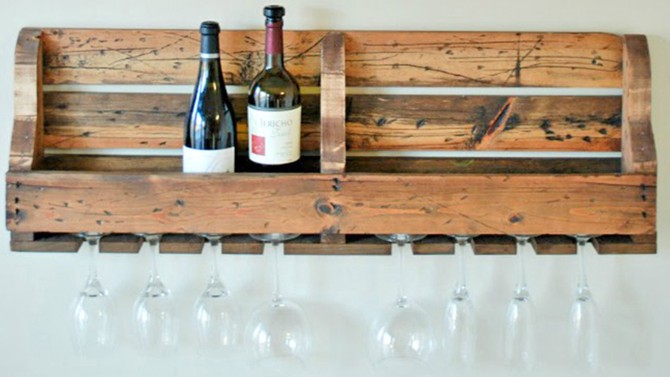
Photo: Audra Kurtz, The Kurtz Corner
The Perfect Gift for Your Wino Best Friend
Project Time: 6 hours
Key Step: After following these directions from The Kurtz Corner blogger Audra Kurtz, to make the main shape, it's time to turn this from a shelf to a wine rack with the addition of a stemware holder. Take a full-length board and mark eight spots where you want your wine glasses to hang. Drill into each mark to create a hole and then cut 1¼-inch wide slits that fit right into the hole for the glass stems. Make sure you leave 2½ inches between each cut so the glasses won't touch.
Don't Forget: This project requires you to use pallets without blocks—so this one, not this.
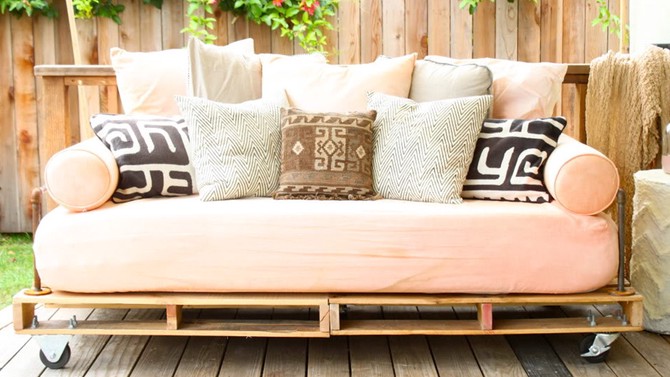
Photo: Jaime Morrison Curtis, Pretty Prudent
A Much-Prettier-Than-Metal Mattress Frame
Project Time: 2 days
Key Steps: Lay two pallets side-by-side and attach the bases together by drilling holes in the sides of the frame that touch each other so that ¾-inch bolts can be inserted through the holes. Screw casters into all four corners of the bed frame as well as in the dead center to keep it balanced. If you are going to use this as outdoor furniture, like Jaime Morrison Curtis, the co-author of Pretty Prudent Home did, coat the wood with polyurethane to protect it from weather damage. Once it's dry, assemble your desired size pipe and flange to create armrests on each end of the bed.
Don't Forget: A standard twin mattress is 39 by 75 inches, but brands differ by a few inches, so make sure you measure the mattress before you buy the pallets. Typically, the size of a pallet is 48 by 40 inches. In this case, to fit a twin-size mattress, you'll need to trim the 48-inch side, which is the side that gets bolted together, to 40 inches. The end result should be a mattress frame that's 40 by 80 inches, which gives you enough room to add the pipe armrests.
Published 07/01/2016

